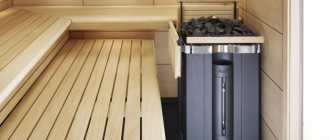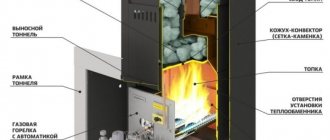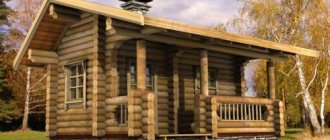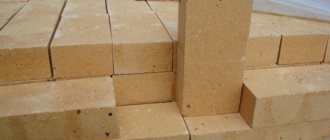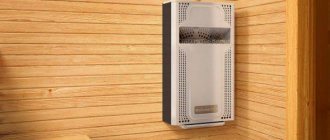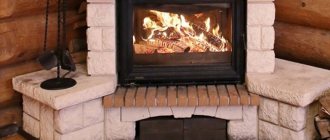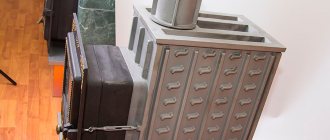Of course, one of the most important elements in arranging a bathhouse is the stove.
Metal stove lined with brick (in the steam room)
Before you begin to study the instructions for proper brick laying, you should answer the main question: why is it necessary to line the stove in a bathhouse with bricks? Perhaps your particular stove model does not require this action?!
Before and after
Compared to metal, brick retains heat much longer, which means the stove will cool down much longer.
The stove in the bathhouse plays no less important role than in the house. The effectiveness of all bath procedures and a comfortable atmosphere depend on how quickly it heats up and retains heat. Being in a cold room is unpleasant, and being in an excessively overheated room is dangerous to your health.
Metal stove in a steam room with 1/2 brick
A little history
Contrary to popular belief, brick kilns did not first appear in Russia. They were brought here already during the reign of Peter I, who personally brought several speeches from Holland and invited experienced craftsmen to share their experience in building such structures.
The reason for this action was not simple curiosity - the number of fires that occurred in the country due to the lighting of black baths was enormous. Since the cities were made of wood, one fire could burn out the entire city (and this often happened).
Peter I issued a decree by which he prohibited the lighting of the bathhouse in the black way. Since then, the tradition of using brick kilns began. The new product quickly gained popularity because it turned out to be relatively safe and quite simple and easy to use. Since then, brick stoves have become the basic method of heating a bathhouse, successfully competing with light metal structures.
Today, brick ovens are used on a par with any other types; they are preferred by a large number of users.
Material that cannot be used for stove masonry
The following types of brick are not suitable for this purpose:
- silicate white
- raw without firing;
- hollow;
- slip.
The first is not a fire-resistant material. Suitable for cladding the outside of houses. The second is hygroscopic. When first fired, it will begin to crack. The third one cannot withstand sudden temperature changes. Deforms under thermal load. The slip brick will simply crumble due to temperature fluctuations.
Design Features
A brick oven is a structure consisting of several elements:
Firebox
This is the main unit of the furnace, made in the form of a chamber for burning fuel;
Chimney
This is a pipe for removing gases and particles formed during the combustion process;
grate
This is a cast iron or brick platform on which fuel is placed;
Ash pan
A chamber located under the firebox and connected to it by narrow slots for the flow of ash from burnt fuel.
Only required elements are listed.
However, most furnaces are equipped with additional components:
Kamenka
This is a pile of stones collected in the immediate vicinity of the firebox, used to create the necessary microclimate in the steam room;
Water tank
This element is found in most stoves, as it allows you to solve the problem of supplying hot water when heating the room.
This is a fairly general structure; in practice there are quite complex structures. In addition, there are special rules and requirements that ensure the efficiency, safety and durability of the structure.
However, if desired, you can build a brick stove for a bathhouse yourself. To assemble the stove, special ordering diagrams are used, which describe in detail the process of laying each row. Referring to this diagram, it is not difficult to build a stove with your own hands, even without experience.
How to stay safe
Standard fire safety rules require that a pre-furnace sheet at least half a meter long , and the distance from the firebox to the nearest wall should be at least one and a half meters.
Brick stove for a Russian bath. There should be a pre-furnace sheet in front of the firebox (marked with an arrow)
Left in the photo: pre-furnace sheets in the store
A brick sauna stove should not be connected to the wall . A gap should be left between them. It is needed primarily due to the thermal expansion of the furnace - with a rigid connection, cracks may appear. And so its surface does not heat up to the combustion temperature of wood.
However, a brick sauna stove is still a fire hazard. It's all about cracks that appear over time both in the stove itself and in the chimney, and can cause sparks to be released. The only way to fight is prevention. The crumbling seams are cleaned and sealed with new mortar.
Advantages and disadvantages
The advantages of a brick sauna stove include:
- the ability to accumulate and release heat for a long time;
- uniform and stable heating of the room;
- attractive and neat appearance
- comfort and ease of use.
The disadvantages of a brick kiln are:
- stationary installation option, inability to move the oven even a few centimeters;
- large weight and size, the need to create your own base (foundation);
- heating the room takes longer than when using metal stoves;
- If used incorrectly, there is a risk of carbon monoxide poisoning.
Expert opinion
Lovkachev Boris Petrovich
Bath master who knows everything about steaming
The advantages and disadvantages of brick kilns have been known for a long time. Users prefer brick baths for uniform and stable heating, safety and ease of use.
If you accidentally touch it, it is more difficult to get a severe burn on a brick oven than when you touch it on the hot body of a metal structure. In addition, the cooling of a brick structure takes much longer - the bathhouse maintains operating mode for several hours.
Types of Fire Bricks
It is obtained by pressing and firing at high temperatures. Depending on the composition, there are several types:
- Fireclay. Optimal stove material. Belongs to a series of aluminosilicate. Which also includes mullite, semi-acid, mullite-siliceous. They are made the same way. They differ only in raw material additives. Fireclay is available in several colors. It depends on the type of clay added. The most reliable is yellow. Can be paired with a ceramic look without losing strength. Provided that the proportions in the solution are observed, such a stove will be durable. The photo below shows an example of fireclay.
- Quartz. Heat resistant material. The main raw material is quartz sand. Low CTE (coefficient of thermal expansion). Together with dinas, it belongs to the series of silica rocks. Externally it differs from chamotte in the absence of dark particles on the surface. It should be noted that this type of refractory brick is used only in areas where it interfaces with the metal elements of the furnace. It is not suitable for interior masonry as it can react with alkaline chemicals.
- Carbon. Coke or graphite is added to the raw material. Withstands temperatures above +16000 C. It is often used for blast furnaces. For home masonry, there is no need to use a material with such heat resistance.
- Alumina or corundum. Its main component is heat-resistant clay. Not afraid of chemicals or temperature changes. Good material for industrial purposes. It is not worth choosing for home structures. Much more expensive than fireclay.
Therefore, to buy high-quality bricks, you should buy yellow fireclay or red ceramic type.
Requirements for construction work
Construction rules (SNiP and SP) require stoves weighing more than 700 kg to build their own foundation. It is necessary to build it separately from the base of the bathhouse, therefore, it is most convenient to build the stove in parallel with the construction of the room itself.
Creating a foundation is the very first stage of furnace construction, which determines the success of further work. Various design options can be used here, from screw piles to a full-fledged poured concrete slab (the most preferred type of foundation).
The stove itself is built from two types of bricks. A special material is used for the firebox - fireproof (fireclay) brick.
You cannot use an ordinary ordinary block - from strong heating it will lose strength and begin to crumble.
An important point is that a rigid connection between the combustion chamber and the outer walls of the furnace cannot be made - thermal expansion of the inner part can cause destruction of the outer walls.
In addition, bricklaying is done using clay, and not using ordinary cement-sand mortar. This is an important point, since clay and fireclay bricks are sintered into a monolith from exposure to high temperatures.
This allows you to maintain the tightness of the firebox even when the external seams begin to crumble - this is an inevitable process that requires constant attention.
If such defects are detected, the defective seam is opened and re-filled with a clay composition.
Solution
In addition to the question of which brick to line the stove in the bathhouse with, you also need to decide on the mortar for the masonry. There are two options: make it yourself or buy a ready-made refractory composition intended for laying stoves. It is a dry mixture, which is diluted with water to a certain consistency in accordance with the manufacturer's recommendations. It includes components that ensure the reliability of the masonry when exposed to high temperatures.
If you follow the traditional path and mix the solution yourself, you can use a simple and cheap clay solution with the addition of sand. This mortar is usually used for laying brick ovens. The process of preparing the mixture is as follows:
- the clay is soaked in water and then rubbed through a sieve to prevent foreign particles and debris from getting into the solution;
- sift the sand;
- Combine the components, mixing thoroughly.
The solution must be plastic. Sometimes 5-10% cement is added to the sand-clay mixture. For furnace work, cement-lime, clay-chamotte or cement-chamotte mortars are also used.
Frequently asked questions
The process of building a furnace is quite complex, raising a lot of questions. Some of them appear for all users. To save time, you need to answer them in advance.
How accurate are the ordering diagrams from the network, are there any errors in them?
Errors are possible in any case, regardless of the source. In order to be on the safe side, you can try to look for ready-made diagrams on specialized forums where there are experienced specialists. They will give accurate diagrams and help with useful advice if something seems unclear.
Is it possible to use screw piles with a channel frame as a base?
Screw piles are a completely acceptable foundation option, especially on heaving or unstable soils. You just need to correctly calculate the load-bearing capacity and immerse them to the required depth. At the same time, the grillage must be made strong enough and a concrete slab must be laid on top of it.
How to choose the oven size?
The size of the stove firebox correlates with the size of the heated room in the range from 1:50 to 1:70. Take into account the size of the steam room and washing compartment. Since the bath heating mode is quite harsh, it is recommended to select a lower value (1:50).
Is it possible to use facing bricks?
To build the furnace, ordinary ordinary brick is used. If you need to finish the stove, you can use clinker tiles - they imitate brickwork as realistically as possible and have a suitable size - only 2-2.5 cm thick.
What to prefer, a brick pipe or a modern sandwich?
The sandwich is lighter. If the stove is small, it is better to choose it and thereby reduce the load on the main structure. However, for large massive ovens you can build brick pipes and save on buying a sandwich.
What materials are suitable for the oven
The main function that a high-quality stove should cope with is heating the room. Some designs (barbecue, grill) have sections for cooking.
Provided that all masonry standards are observed, the mortar is properly mixed and the material is selected, fuel consumption will be economical and heat transfer will be high.
Depending on the type of masonry, there are bricks:
- Facial. Used for lining the finished stove, with a homogeneous structure. It has a neat appearance, smooth sides.
- Private, full-bodied. Used for interior masonry.
Builders recommend inspecting all the material before work and immediately sorting out any defective materials with chips or cracks. It is better to take one type and batch.
Let's take a closer look at the main types of heat-resistant bricks.
Ceramic
Produced in two ways:
- semi-dry pressing;
- plastic molding.
In the first case, the raw material passes through a special nozzle - a die, as a result of which the layer acquires the desired shape, is cut, and only then is subjected to high-temperature treatment.
In the second, the prepared mass is laid out in molds and kept under pressure. Then it is fired for 12–15 hours at +11500 C. This way the dimensions are more accurate and the surface is smooth and neat.
The most suitable brick for stoves and fireplaces is ordinary red ceramic and front plastic molded. They are laid out only from solid single ones with identical modules.
Clinker
To make it, they use a clay mass - clinker, which is fired at temperatures up to 15,000 C. In fact, this is a standard heat-resistant brick.
Has a high thermal conductivity. Dark color. Lasting. The material is practically without pores, so it tolerates frost well.
Heavy in weight. Often combined with red ceramic bricks. Resistant to chemicals. But due to its high cost, it is not very popular among stove makers. And in terms of heat resistance, it is significantly inferior to fireclay.
Popular manufacturers of furnace material
There are a sufficient number of them on the construction market. The price of refractory bricks ranges from 16 to 60 rubles per 1 piece. They sell it in pallets of 320–360 pieces or by weight for 1 ton. The approximate cost of the material in both cases is up to 14 thousand rubles per pallet or ton.
Below are the most popular manufacturers of good quality heat-resistant bricks.
Wienerberger AG
An Austrian concern, which is considered the world market leader in the production of tiles and bricks. Its factories are located in 30 countries. Russia is also one of them.
A popular stove material is Terca brand refractory brick.
Lode
Lode is a Latvian manufacturing plant. Specializes in the production of various types of bricks.
The stove material produced by him, type M500, is popular - red, solid, with a high frost resistance. Suitable for laying indoors and outdoors.
Photo: preparing bricks for shipment
Has three working surfaces. It has several release forms. The semicircular one is in greatest demand. Its plus is its aesthetic appearance, due to which the lining of the stove looks neat.
Heylen Bricks
Belgian company. It has been producing bricks of all shapes and brands for more than 100 years. The products are distinguished by their strength, durability, and a rich palette of colors. This is one of the few companies that fulfills orders for the production of material for stoves, houses, cottages, garages, saunas, so that the client can bring his original ideas to life. The customer can participate in the production of the material itself.
The only negative is the high prices of imported products.
Vitebsk plant
The official name is OJSC Keramika. Production facilities are located in the Republic of Belarus.
Photo: Belarusian product
The main products are red ceramic bricks of the M180, M200 brands, which are used for cladding stoves and fireplace structures. The price is quite reasonable. But you should not work with this material in areas with high humidity levels.
Conclusion
Choosing quality bricks is quite a troublesome task. For masonry, only dense, defect-free material can be used. You should know that each part of the furnace has its own type. For the firebox, ash pan, chimneys - fireclay, for the chimney - frost-resistant, for finishing - ceramic or clinker facing. Although low-quality material is cheaper, it is not suitable for building a furnace. By saving on quality, you will get a short-lived and fragile structure that will last a maximum of one season.
Creation of stove structures for a bath: fireclay brick and its characteristics
A sauna stove is a rather complex device that combines almost all human knowledge in the field of physics and energy. With each new year, the market is replenished with innovative models of such devices, characterized by increased productivity and fuel economy. Similar devices have a high cost and therefore are not always the best option for use in your own bathhouse. An alternative to innovative products is to build classic brick ovens, which not only saves a significant amount of material resources, but also produces an excellent device characterized by increased productivity.
The construction of such a furnace requires the use of a special material that differs from the ordinary one. One of the best product options existing on the modern market is fireclay brick, which has all the necessary qualities for creating similar objects. These criteria are the following properties inherent in such a material and distinguishing it from other models:
The above qualities and their presence are mandatory criteria that you should pay special attention to when choosing material for laying the stove. The selected material should best comply with these indicators, which will allow you to get an excellent and functional device that can warm up the bathhouse and maintain the required temperature in it. In turn, the use of ordinary bricks, which do not differ in such indicators, can lead to deformation of the structure and a violation of its characteristics.
Let's sum it up
So, which brick is better for the stove? To build a high-quality stove, you need to choose the right brick. It should be:
- Full-bodied.
- High Quality.
- Refractory.
- Density grade 200 – 250.
- Possess high frost resistance.
- Comply with GOST.
One final piece of advice: always buy enough bricks to avoid a situation where there is not enough building materials. It is not recommended to purchase additional bricks later, since stones from different batches may differ in color and quality.
Watch the video: “Which brick to choose”
